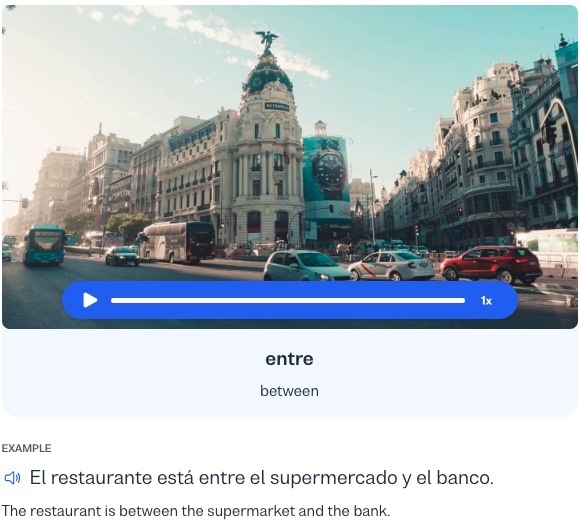Understanding Prepositions in Spanish
Prepositions make sentences work. Get to know how with this guide.
I want to learn...
Prepositions are a fundamental part of the Spanish language. They help provide the necessary context and structure to create relations between words by indicating location, direction, time, manner, possession, and more. Understanding how prepositions work is crucial for building grammatically correct and meaningful sentences.
In this comprehensive guide, we will dive into Spanish prepositions, explore their rules, exceptions, and provide practical examples.
Prepositions explained
Prepositions are words that link nouns, pronouns, or phrases to other words in a sentence. They typically express spatial, temporal, or logical relationships.
The most common prepositions in Spanish include “sobre” (above), “hacia” (toward), "a" (to), "en" (in, on), "con" (with), "de" (of, from), "por" (by, for), and "para" (for). And there are many others that you’ll learn as you go along.
Certain verbs are followed by specific prepositions, such as "pensar en" (to think about) or "soñar con" (to dream of/about).
Use of prepositions
Prepositions have different uses depending on the situation. The four main types are space, time, manner or possession and they aim to connect objects with one another, nouns with verbs or adverbs, etc.
1. Spatial relationship
These prepositions indicate the location or position of an object or person in relation to another.
- El libro está sobre la mesa. (The book is on the table.)
- María camina hacia la puerta. (María is walking towards the door.)
2. Temporal relationship
They are used to express time-related relationships. For example:
- Llegaré a las cinco. (I will arrive at five o'clock.)
- No quiso hablar durante la película. (He didn’t want to talk during the movie.)
3. Manner
These prepositions describe the way or manner in which an action is performed. For example:
- Habla con educación. (He speaks with politeness.)
- Ella trabaja mejor bajo presión. (She works better under pressure.)
4. Possession
They indicate possession or ownership. For example:
- El perro de Juan es muy juguetón. (Juan's dog is very playful.)
- Este libro es para ti. (This book is for you.)
Rules and guidelines for prepositions
As with most things, prepositions have a few rules that are important to keep in mind, mainly placement, agreement and the “a” (don’t worry, we will go through this in a second).
Placement
When you look at the meaning of the word, pre- means “before,” and -position is “to put”. In that sense, preposition means “to put before.”
- Estoy en casa. (I am at home.)
- Él habla con su hermana. (He is talking with his sister.)
Contraction in “de” and “a”
This is a phenomenon that only happens with the prepositions a and de, when the preposition is followed by the masculine article el. This would turn a into al, and de into del. But if the article is la, there’s no contraction.
- Me gustan las flores del jardín. (I like the flowers from the garden.)
- Voy a la playa. (I am going to the beach.)
The personal “a”
Finally, let’s look at the personal “a.” Basically, when a direct object is a person or a pet, it is preceded by the preposition "a."
- Veo a Juan en el parque. (I see Juan in the park.)
- Quiero adoptar a un perro. (I want to adopt a dog.)
Spanish prepositions are the connective threads that give depth and meaning to our sentences. Understand their usage, learn the rules, and practice regularly. This way you can enhance your Spanish language skills and communicate more effectively.
Read Spanish texts, listen to native speakers, and engage in conversations to reinforce your understanding of prepositions in context.
Finally, pay attention to idiomatic expressions and collocations involving prepositions, the rules and exceptions won’t truly shine until you apply your knowledge to the real world.
Having trouble understanding prepositions?
Busuu can help you out with free online courses, an extensive resource archive, and a community of native speakers and learners.
Click below to start learning Spanish – or one of the other 13 languages we offer!

